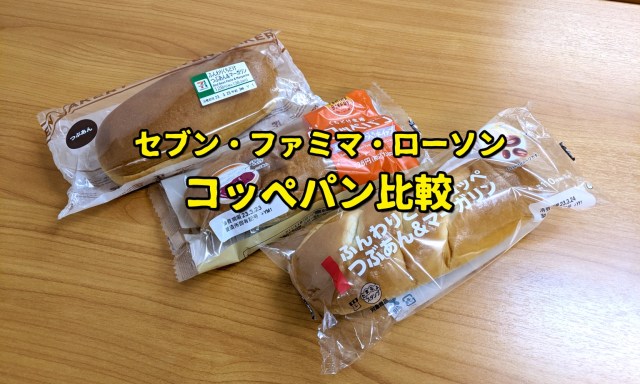
7-Eleven, Lawson and Family Mart go head to head in the battle of the bread buns.
Japanese convenience stores are well-known for their onigiri rice balls, hot foods, and bento boxes, but some of their top-selling items are actually located in the bread aisles.
Over at Family Mart, for instance, the new Nama Koppepan series has been raking in the sales since its debut on 28 February, with a whopping five million sold in the 12 days after its launch.
▼ Family Mart’s Nama Koppepan
For the uninitiated, koppepan takes its name from “coupé”, the French word for “cut”, and “pan”, the Japanese word for bread. Despite its fancy name, it’s essentially a soft white hot dog bun, and it can be filled with all sorts of ingredients, from red bean paste through to yakisoba noodles.
Children grow up eating koppepan as part of their school lunches, giving it broad appeal for both lovers of soft bread and anyone wanting to take their taste buds on a trip down memory lane. But what makes Family Mart’s koppepan such a breakout hit?
Our Japanese-language reporter Mr Sato was curious to find out, so he went on a mission to purchase a koppepan from each of the top three convenience store chains — Family Mart, Lawson, and 7-Eleven — and take them back to the office for a taste test.
Mr Sato didn’t think there could be much of a difference between them, but he was about to be pleasantly surprised, so let’s take a look at how this taste test panned out, starting with his visit to 7-Eleven.
▼ He purchased the “Red Bean Paste & Margarine” variety for 138 yen (US$1.06), manufactured by Tower Bakery Company.
Over at Lawson, he found the koppepan in a similar spot in the bread aisle, unceremoniously stocked beneath a collection of rounder white rolls.
▼ He picked out the “Fluffy Coarse Sweet Red Bean Paste & Margarine” for 119 yen, manufactured by Yamazaki Baking Company.
Over at Family Mart, the koppepan stood out with the grand display we shared earlier, promoting the bread in its two debut varieties:
▼ Egg (left) and Sweet Red Bean Paste and Whipped Cream (right)
The range has been so popular that a Ham Cutlet version (pictured below) was added to the lineup on 21 March, but Mr Sato needed to keep things on an even playing field, so he returned with the…
▼ …Sweet Red Bean Paste and Whipped Cream (138 yen), also manufactured by Yamazaki Baking Company.
Comparing all three in terms of weight, he found there was a large difference between them — the 7-Eleven roll weighed in at 117 grams (4 ounces), while Lawson was the heaviest, at 137 grams, and Family Mart’s was the lightest, at 96 grams.
They looked different too — Family Mart’s (left, below) was the smallest of the bunch, with 7-Eleven’s roll being slightly larger and Lawson’s being noticeably larger than both of them, despite being the cheapest one of all.
▼ Left to right: 17 centimetres (6.7 inches) in length for 7-Eleven, 19.5 centimetres for Lawson and 16 centimetres for Family Mart.
Looking at the cross sections, the koppepan from 7-Eleven (left, below) and Lawson (middle) don’t look too dissimilar, but take a look at Family Mart’s on the right!
▼ The addition of fresh cream makes Family Mart’s koppepan look particularly appetising.
Fresh cream, or “nama cream” as it’s known in Japan, is what “nama” refers to in Family Mart’s Nama Koppepan, and based on appearances, this may be the thing that sets it apart from its competitors.
The truth is in the tasting, though, so Mr Sato took a bite out of the 7-Eleven bread and found that it was a good, orthodox koppepan, with nothing to make it stand out as different from any other he’s ever eaten. It was safe, in both a good way, and a bad way.
The Lawson roll was large and good value for money, providing more satisfaction with an extra 40 grams by comparison. However, it wasn’t particularly impressive either — in fact, he thought the balance between bread and filling was slightly below par.
When it comes to Family Mart’s koppepan, though…
▼ …this was a roll to write home about!
Despite being the smallest of the bunch, it was the tastiest by far. After doing some research online, Mr Sato discovered the fantastic flavour was likely due to the fact that Family Mart adds fresh cream to the brioche dough, which uses about eight times the eggs and about 15 times the margarine of a conventional koppepan.
This results in a moist dough that leaves no dry feeling in the mouth. While the rich ingredients might create a more calorie-dense roll, it’s smaller and lighter than the others, which evens out the difference without compromising on flavour.
After tasting all three rolls, Mr Sato realised there can be a great difference between koppepan. They’re not all made the same, so if you’d like to try the best version of a roll that people in Japan grew up eating, he recommends heading to Family Mart…or perhaps the Dagashi Bar, where you can sit down and order a koppepan in a tavern-like setting.
Images © SoraNews24
● Want to hear about SoraNews24’s latest articles as soon as they’re published? Follow us on Facebook and Twitter!
[ Read in Japanese ]